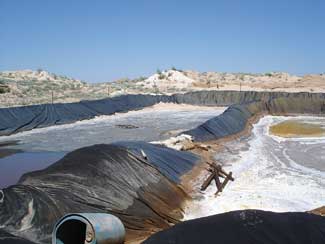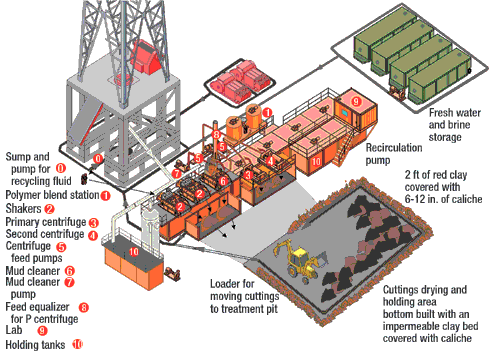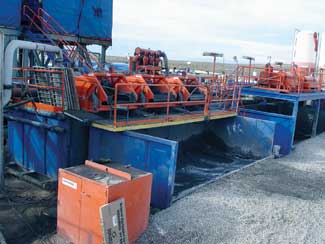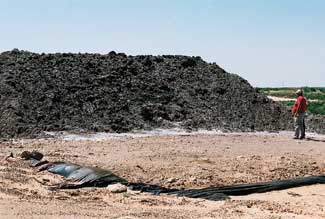Environmental Technology
Closed-loop drilling system: A viable alternative to reserve waste pits
It is cost-effective and, in some cases, cheaper than using pits.
Dorsey Rogers and Dee Smith, Cimarex Energy Co.; and Gary Fout and Will Marchbanks, M-I SWACO
A uniquely engineered on-site drilling waste treatment system holds the potential for eliminating or dramatically reducing the widespread use of environmentally problematic reserve pits, while lowering costs in the process.
Known as de-watering or closed-loop drilling, the process has been used successfully on nearly 40 wells in Lea and Eddy Counties, New Mexico. The technology not only significantly reduces waste volume, long-term liability and costs but the dry condition of the treated material enhances disposal or re-use characteristics.
The chemical and mechanical process involves removing and treating drilled solids from the system, with the waste collected in a modified steel catch tank. The pitless drilling process also is equipped with a mud de-watering system consisting of a chemically enhanced centrifuge package. Once the solids and liquids are separated, a front-end loader removes the waste, which is stacked on a specially prepared pad, comprising compacted clay dirt over a plastic liner to prevent infiltration of any draining liquid. A drainage ditch collects runoff from rainwater. The recovered drilling fluid is stored in 500-bbl tanks and re-used in active mud systems.
Consequently, drilling fluid is no longer a disposal item, but is moved from well-to-well. Contaminated fluids are reconditioned by the dewatering equipment and mud products.
RESERVE PIT ENVIRONMENTAL LIABILITIES
Since the early days of drilling, so-called double horseshoe reserve pits (Fig. 1) have peppered the landscape throughout much of the Western US and elsewhere in the world. The earthen pits primarily are used to collect and retain drill cuttings for eventual disposal, but also hold base fluids, such as brines, cut brine or fresh water. To a limited extent, they also act as solids-control devices by settling solids in the outside ring of the horseshoe.
 |
Fig. 1. Example of a double horseshoe pit, which all-too-often becomes a private waste dump.
|
|
In the past, pits have been incorporated extensively in the solids-control system used to process drilling fluid. The inside portion of the pit generally holds fresh water for drilling surface hole and, later, brine for dilution of drilled solids in the active mud system. The outside portion of the pit is used to hold and settle solids while recovering fluid from the other end.
The use of this type of pit has played an important role in the development of oil and gas reserves. In the early days of drilling, salt zones were encountered, thus generating brine mud naturally. As understanding of the drilling process increased, it was found that low-gravity solids in the brine contributed to many downhole problems including slower penetration rates and wall sticking. The inadequate solids-control equipment available during that period mandated a pit design that allowed some retention time prior to having to reuse the discarded fluid. A practical design was developed which was the horseshoe pit, still used today.
The double horseshoe design allows solids discarded from the solids control system to settle in the first part of the pit. Fluid continues to flow to the “deep” end where it can be recovered and re-used. In fact, this system became so effective that very large pits were developed with practically no solids control. This system was called circulating the pit, where the only practical solids control was gravity-induced settling.
Besides being eyesores, reserve waste pits carry a host of environmental liabilities, not the least of which are the risks of breached liners contaminating the sub-soil and underground water aquifers. The US Bureau of Land Management (BLM), which controls much of the drilling acreage in New Mexico and elsewhere in the Western US, has endorsed this zero discharge process.1 In the latest edition of its “Gold Book,” the BLM recommends operators employ closed-loop drilling systems to prevent soil contamination and to conserve water, which is a precious commodity in the arid West. Likewise, many private ranchers also have voiced dissatisfaction with the waste pits associated with the drilling rigs operating on their properties.
Owing to tightening environmental regulations and a more thorough understanding about the fate of the contents left in the pit, several alterations were made over the years to the design and content handling. While the BLM requires reserve pits be appropriately fenced to prevent access by persons, livestock and wildlife, all-too-often they have become the site of pirate dumping for everything from used motor oil, paint to household chemicals, Fig. 1. Where local environmental conditions are of major concern, the use of pits has been limited or banned entirely.
Barring the use of closed-loop or pitless drilling, the BLM recommends that pits be encircled with synthetic liners or materials such as bentonite or clay, which are intended to keep the fluid from infiltrating the substrate beneath the pit.1 The liners must be installed so they will not leak and must be composed of materials compatible with all the substances to be placed in the pit.
Depending on the proposed contents and sensitivity to the local environment, the surface management agency also may require a leak detection system or the use of self-contained mud systems, where the spent drilling fluids and cuttings are transported to approved disposal sites.
On the state level, in 2004, the New Mexico Oil Conservation Division (OCD) implemented a controversial set of pit creation and closing guidelines that require off-site disposal.2 Traditionally, operators would allow the liquids in a reserve pit to evaporate and then enclose the remaining solid components, usually rock and concrete, and bury the mix on-site. Under the new guidelines, operators not only must receive a permit for a reserve pit, they must make arrangements to have the pit removed and disposed of off-site, which increases costs appreciably.
Another regulation requires operators “de-water” the pit prior to closure. This has the effect of removing salt from the pit, which otherwise would have been left in place. It also removes much of the driving force (water) behind dissolved solids leaching into the substrate. These steps are similar to those taken by landfills to ensure the dry entombment concept.
These actions may or may not have had an impact on removing the detrimental impacts of salt from the environment. Moreover, it is doubtful a plastic liner will remain intact throughout the life of the pit. While de-watering the pit definitely removes some salt water, much remains trapped in the remaining solids. Disposition of the pit contents is limited, since the plastic liner is usually cut and removed where it is visible at the end of the well, but the lower portion of liner is covered with cuttings. Since the cuttings have trapped the lower portion of the pit liner, ultimately, the cuttings will be mixed with the shredded plastic. This mixture makes any form of disposal other than burial much more difficult.
Using horseshoe pits also impacts the amount and character of the waste generated. Since a large pit generally discourages effective solids control and encourages a practice known commonly as “dump and dilute,” waste volumes are increased dramatically. In this practice, ineffective solids control leads to a build-up of drilled solids in the drilling fluid. A low drilled-solids concentration is maintained by dumping dirty fluid and diluting with relatively clean fluid from the pit.
Conventional solids-control equipment removes drilled solids with some associated fluid, but the amount of liquid removed is relatively low compared to the dump-and-dilute method. Shale shakers and centrifuges are said to remove about one part fluid with one part drilled cuttings. A centrifuge combined with chemically enhanced dewatering allows for removing all solids from a fluid stream.
By comparison, dilution creates much higher volumes of fluids to solids, as one might expect. If dirty fluid is dumped when the solids concentration reaches 10%, the amount of fluid removed with these drilled solids is 10 parts fluid to one part drilled cuttings. If the fluid is dumped at 5% drilled solids, then the removal ratio is 20 parts fluid to one part drilled cuttings.3 Table 1 shows typical volumes.
| TABLE 1. Volumes at various solids control efficiency |
 |
|
Another development occurred in the early 1990s, when so-called reserve-pit management systems were conceived as alternatives to conventional pits.4,5 This management system uses a network of at least four separate pits constructed in an area that otherwise would be occupied by a standard horseshoe pit. In this process, separate pits are constructed for shaker solids, settling, storage and emergencies. With this system, wastes, such as salt cuttings, unexpected saltwater flows and drilling fluids with high barium concentrations, are separated from normal and uncontaminated drilling waste, thus minimizing the volume of contaminated waste requiring handling. Furthermore, solids may be removed from pits for appropriate management during the drilling operation, while water from segregated pits is made available for a mud system, thereby lowering costs.
More recently, improvements in solids control equipment coupled with innovations in chemical flocculants and coagulants have allowed high solids-control efficiencies to be achieved without water-intensive dilution. The solid waste generated contains very little associated fluid. The novel process has dramatically changed the volume and character of generated waste, while clearing the way for more disposal options and reducing costs and future liability.
THE PITLESS DRILLING PROCESS
Drilling without a pit requires very high efficiency in solids-control, since cuttings not removed from the mud system reduce penetration rate and induce wall sticking. Dilution of solids remaining in the mud will create excess fluid and this, in turn, will create excess waste. Without a pit for storage, this fluid must be transported off-site for disposal, which increases the cost.
The novel de-watering system processes water-based drilling fluid at the rig site with very high efficiency and with relatively low retention of fluids and removed cuttings. Further, the footprint of the drilling operation is reduced significantly.
Figure 2 shows a schematic of the process. The system comprises shale shakers sized to run fine screens at the required flowrate. Generally, for the hole size and flowrate involved, two shakers will be required and both can be fitted with 175- to 200-mesh screens, Fig. 3.
 |
Fig. 2. Schematic of the closed loop dewatering layout used in New Mexico. The key components are the pad, frac tanks for reserve and recycled fluids, cement handling, and the solids control and dewatering equipment.
|
|
 |
Fig. 3. Shale shakers are an integral part of the process.
|
|
In addition, the system is equipped with a water-based mud de-watering system consisting of a chemically enhanced centrifuge package. The centrifuge can remove fine particles not removed by conventional shale shakers or hydro cyclones. Chemical flocculants or coagulants are injected into the suction line, which runs from the pump to the centrifuge feed line, along with the drilling fluid to be processed. The chemicals cause the fine particles of drilled solids to clump. Besides removing fine particles, the removed mass is relatively dry.
As drilled solids are removed, the waste is collected in a modified steel tank before being stacked on a specially prepared pad. The pad is constructed of compacted clay dirt about 6-in. thick over a plastic liner to prevent infiltration of any draining liquid. The perimeter of the pad is lined with ditches to prevent run-off. The stacked cuttings are piled, mixed and turned to expose the small amount of liquid to the air for evaporation. Occasionally, a minimal amount of dirt or lime is added to aid in drying. The cuttings pile soon becomes dry enough to resemble a large mound of dirt, Fig. 4.
 |
Fig. 4. The dryness of the cuttings aids disposal or re-use.
|
|
The generated cuttings pile represents the total waste volume, since no significant amount of fluid, other than contaminated mud/ cement returns, has been removed for disposal. For example, the volume of cuttings estimated in one Lea County well was 29,000 ft3 (819 m3). This represents a ratio of 4.6 times the gauge hole volume compared to 10-to-20 times hole volume for cuttings and fluid left in the pit for disposal under the previous operating mode, Table 1. As a result, sludge has been reduced by 60 to 70%, thereby minimizing long-term liability exposure dramatically.
Cost of pit vs. pitless drilling. One of the complaints operators have voiced over the use of closed-loop drilling systems is what they perceive as increased costs. However, economic analysis suggest otherwise.
The cost of constructing and possibly lining an earthen pit must first be considered, along with the high volume of water that will be needed on location for dilution. If mud is required, those costs may be high relative to mud costs with reduced fluid usage. After drilling, fluid is removed from the pit and disposed of, while solids are either hauled off for disposal or buried in place. The only cost that may be minimized or eliminated altogether is the rental of solids-control equipment, which is not employed extensively when using a pit.
With a closed-loop system, costs for equipment rental and surface handling of the removed discard increase. In addition, a staging pad must be constructed to store and dry the material before ultimate disposal. Conversely, although difficult to quantify, maintaining low levels of low-gravity solids can increase penetration rates and reduce the non-productive time typically associated with stuck pipe and loss of circulation. Further, since the required fluid volume is reduced in a closed-loop system, mud and water usage costs also are decreased.
In the New Mexico project, the results of this analysis indicate that eliminating pits is cost-effective and does not add significant cost to the overall operation. Furthermore, when solids must be transported for off-site disposal, eliminating the pit actually reduces costs.
Since other aspects of the overall drilling operation have a ripple-down effect on solids-control and waste management costs, developing a definitive comparison between pit and pitless drilling can be a difficult proposition. However, an analysis of the New Mexico operation revealed that the average cost of using a pit and hauling the waste elsewhere for disposal is about 45% more compared to following the same process without a reserve pit. Moreover, the analysis showed that burying the waste on-site costs about 24% more when using a reserve pit as opposed to employing the closed-loop system.
Re-use of waste material. Treated wastes are either buried on-site in specially engineered cells or delivered to approved commercial disposal sites. Although a field trial is yet to be conducted, analysis are now underway to determine the feasibility of re-using the treated material in the construction of road beds, drilling/ production pads and other specialty applications.
The re-use of treated drilled cuttings to replace conventional road-bed material has often been discussed. Roads are made with an initial layer called the sub-grade or basement soil, which is covered by a sub-base and, finally a base. In oilfield construction, the base probably represents the final layer, as the roads are rarely paved, although gravel may be added on top of the base.
Standards of the American Association of State Highway and Transportation Officials (AASHTO) describe specifications for sub-base materials. Most drilled cuttings do not resemble soil-aggregate mixtures described in these specifications, unless heavily treated. Even then, the treatment must address how to create aggregate material versus slab-solidified material.
However, cuttings piles generated in the New Mexico de-watering project differ considerably from most drilled solids. Since the cuttings piles are dried naturally, the moisture content is extremely low in its final state, requiring no treatment to dry it further, Fig. 3. In addition, the material resembles native dirt with low clay content, which is desirable in sub-base materials to prevent swelling and shrinking.
The prospects of using cuttings as sub-base material for future drilling/ production pad construction appear even more promising. In this application, the cuttings material is covered by caliche, which is a dry, heavy clay material. By incorporating caliche, any salt contained in the cuttings would present very little risk of pollution. Basically, this cap would be very similar to the one recommended for burial, although with this process the cuttings are on the surface.
In the long term, the drilling pad is converted to a production pad. The life of the production pad probably exceeds 10 years and could easily exceed 20 years. In terms of the re-use value of the cuttings, a material resource of similar nature is replaced, and the potential pollution factor of the cuttings material is very low. Rather than being commingled with other companies’ waste in a commercial disposal site, the material remains under the authority of the operator who generated the waste.
Most standards developed for drilled cuttings disposal focus on agricultural use. Whether the cuttings are buried, mixed or spread over the land, they must be suitable for growing crops or, at least, not interfere with growing crops. As such, tight standards have been placed on salt and its measurement. Since crops are not grown on a drilling pad, high salt content is not an important consideration, so long as the salt does not leach from the pad location. Here, the material is protected by the caliche cap and, since water is not present, the force that would drive leaching is removed.
Other specialty beneficial re-use applications also are under study, including using the treated cuttings for wetlands restoration. 
LITERATURE CITED
1 United States Department of the Interior, Bureau of Land Management, “Surface Operating Standards and Guidelines for Oil and Gas Exploration and Development (The Gold Book),” fourth edition, 2006.
2 Clay Holtzman, “State might rue new oil pit rules; industry does,” New Mexico Business Weekly, April 22, 2005.
3 Dorsey Rogers, Gary Fout and William A. Piper, “New innovative process allows drilling without pits in New Mexico,” presented at The 13th International Petroleum Environmental Conference, San Antonio, Texas, Oct. 17 – 20, 2006
4 Pontiff, et al., “Theory, design and operation of an environmentally managed pit system,” Proceedings of the First International Symposium on Oil and Gas Exploration and Production Wastes, New Orleans, Sept. 10 – 13, 1990.
5 Spell, et al., “Evaluation of the use of pit management system,” Proceedings of the First International Symposium on Oil and Gas Exploration and Production Wastes, New Orleans, Sept. 10 – 13, 1990
|
THE AUTHORS
|
 |
Dorsey Rogers is the Denver-based Cimarex Energy Co. field drilling superintendent and co-coordinator of regulatory compliance for Permian Basin Operations. He has 35 years of experience in domestic and international operations, including 15 years as operations superintendent for various international operators. Rogers has an extensive background in oilfield chemistry for drilling, completion and workover fluids. He has owned and operated an oilfield laboratory that primarily dealt with environmental measurements. He is an active member of SPE. He studied chemistry and economics at Metro State University in Denver.
|
|
 |
Dee Smith is the Permian basin drilling superintendent for Cimarex Energy Co. He has more than 35 years of experience in domestic and international drilling, holding various positions for Santa Fe Minerals, Vintage Petroleum, Kerr McGee and Andover. He has managed drilling projects in South America, the Middle East, Europe and Trinidad, along with geothermal work in Northern California. Smith holds a Bachelors Degree in Accounting from East Central Oklahoma University in Ada, Oklahoma.
|
|
 |
Gary Fout is senior executive account manager for M-I SWACO and is based in Houston. He began his career with the company in 1976 and has held a variety of positions in operations, sales, facility management, technical services and engineering. He has designed and built various waste treatment systems, including waste minimization systems, solidification, thermal disorption, bitumen extraction from tar sands and dewatering. During his career he also designed and built surface equipment for managing fluids and pressures for underbalanced drilling. He holds a computer programming certificate from the American Computer Academy, Kansas City, Missouri.
|
|
 |
Will Marchbanks is senior account manager for M-I SWACO and based in Houston. He began his career with Magcobar in 1976 as a drilling fluid engineer working offshore and land along the Gulf Coast. He has held a variety of positions as manager in operations and procurement in the fluids divisions. Marchbanks has worked worldwide as a Technical Service technical in trouble shooting solidification, dewatering, and waste minimization projects. He holds an Associate of Science degree in petroleum technology from TJC.
|
|
|











